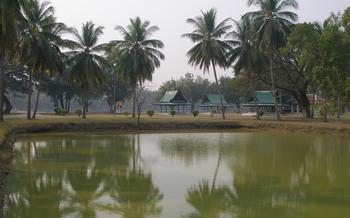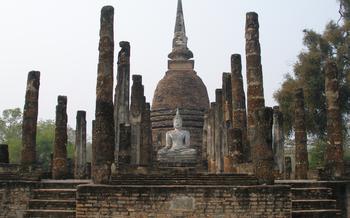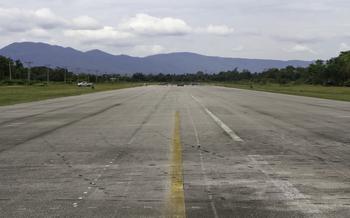
Baan Phumriang
- A Journey to Baan Phumriang: A Village Steeped in Tradition
- Cultural Immersion at the Village
- Exploring the Village's Architectural Heritage
- Visiting the Village's Temples and Shrines
- Strolling through the Village Market
- Taking a Cooking Class
- Visiting the Baan Phumriang Museum: A Journey Through History and Culture
- Attending Local Festivals and Events
- Supporting Local Handicrafts
- Engaging in Volunteer Opportunities
- Learning About Local History and Folklore
- Respecting Local Customs and Traditions
- Staying in a Homestay
- Insider Tip
A Journey to Baan Phumriang: A Village Steeped in Tradition
Baan Phumriang, nestled amidst the picturesque landscapes of Nakhon Si Thammarat, Thailand, is a village steeped in history and tradition. Founded over 200 years ago by a group of skilled woodcarvers, Baan Phumriang has preserved its unique heritage and way of life, making it a captivating destination for travelers seeking an authentic glimpse into rural Thailand.
The village's rich history is intertwined with the art of woodcarving, a skill that has been passed down from generation to generation. This intricate craftsmanship is showcased in the exquisitely carved wooden houses that line the village streets, each adorned with intricate designs and symbolic motifs.
Beyond its architectural wonders, Baan Phumriang is renowned for its strong sense of community and its commitment to sustainable tourism. Visitors are warmly welcomed and encouraged to immerse themselves in the village's daily life, participating in traditional activities, sampling local cuisine, and learning about the importance of community cooperation.
Cultural Immersion at the Village
Baan Phumriang offers an unparalleled opportunity for cultural immersion. Engage with the villagers, immerse yourself in their daily life, and experience their warm hospitality. Participate in traditional activities and workshops, learning the art of wood carving, weaving, or pottery. Discover the secrets of local cuisine in cooking classes, savoring the flavors of authentic Thai dishes prepared with fresh, locally sourced ingredients. Embrace the sense of community and cooperation that permeates the village, where everyone contributes to the well-being of the collective. By immersing yourself in the cultural tapestry of Baan Phumriang, you'll gain a profound understanding of Thailand's rich heritage and the enduring spirit of its people.
Exploring the Village's Architectural Heritage
Baan Phumriang boasts a unique architectural style that sets it apart from other villages in Thailand. The houses here are characterized by their intricate wood carvings and intricate designs, making them a visual delight for visitors. The carvings depict various motifs and patterns, from flowers and animals to mythical creatures, each with its own significance and symbolism. These decorations not only enhance the beauty of the houses but also tell stories and convey messages about the community's beliefs and values.
The wooden carvings on the houses are a testament to the skill and artistry of the local craftsmen. Each house is adorned with unique carvings, making it a one-of-a-kind work of art. The intricate details and craftsmanship reflect the deep respect and appreciation that the villagers have for their cultural heritage.
Preserving this architectural heritage is of utmost importance to the community. The villagers actively work to maintain and restore the traditional houses, ensuring that future generations can appreciate and enjoy this unique aspect of their culture. Visitors can contribute to these preservation efforts by supporting local initiatives and respecting the community's traditions.
Visiting the Village's Temples and Shrines
Baan Phumriang is home to several sacred sites that hold deep significance for the community. Among them, the most prominent are the village's temples and shrines. These places of worship are not just architectural marvels but also centers of spiritual and cultural life.
The temples in Baan Phumriang showcase elaborate architecture that reflects the village's rich artistic heritage. Intricate carvings, colorful murals, and graceful stupas adorn these sacred spaces, creating a visually stunning spectacle. Each temple has its unique character and history, embodying the beliefs and traditions of the local community.
Beyond their architectural beauty, the temples in Baan Phumriang serve as venues for important rituals and ceremonies. Villagers gather here to celebrate religious festivals, offer prayers, and seek blessings. Visitors are welcome to observe these ceremonies respectfully, gaining insights into the spiritual practices and beliefs of the local people.
It is important to remember that temples and shrines are sacred places, and visitors should behave respectfully. Proper attire is recommended, and it is customary to remove shoes before entering the temple grounds. Visitors should also refrain from loud talking or disruptive behavior, maintaining a peaceful atmosphere for worship and meditation.
Strolling through the Village Market
The village market is the heart of Baan Phumriang, a vibrant tapestry of colors, sounds, and aromas. As you wander through the narrow alleys, you'll find an array of local products and handicrafts for sale. From intricately woven textiles to beautifully crafted pottery, each item tells a story of the village's rich heritage.
Bargaining is a way of life at the market, and vendors are always eager to strike a deal. Don't be afraid to haggle politely, but always do so with respect. The market is also a great place to interact with the villagers, who are always happy to share stories about their products and the village's traditions.
By shopping at the market, you're not only supporting the local economy but also contributing to the preservation of the village's unique culture. So, take your time, soak in the atmosphere, and bring home a piece of Baan Phumriang's charm.
Taking a Cooking Class
Immerse yourself in the culinary traditions of Baan Phumriang by taking a cooking class. Learn to prepare traditional Thai dishes using fresh, local ingredients and unique recipes. Engage with local chefs, discover their techniques, and bring a taste of Baan Phumriang back home.
Cooking classes typically start with a visit to the local market, where you'll learn about the ingredients used in Thai cuisine. You'll then head to a traditional kitchen and start cooking. Dishes may include popular favorites like Pad Thai, Green Curry, or Mango Sticky Rice.
The chefs will guide you through each step, from chopping and slicing to mixing and cooking. They'll share tips and techniques that will help you recreate these dishes at home. You'll also learn about the history and cultural significance of each dish.
At the end of the class, you'll sit down to enjoy the delicious meal you've prepared. This is a great opportunity to savor the flavors of Baan Phumriang and share your culinary creations with new friends.
Whether you're a seasoned cook or a beginner, taking a cooking class in Baan Phumriang is a fun and rewarding experience. It's a chance to learn about Thai cuisine, engage with the local community, and create lasting memories.
Visiting the Baan Phumriang Museum: A Journey Through History and Culture
Nestled in the heart of Baan Phumriang, the village museum stands as a testament to the community's rich history and vibrant cultural heritage. A treasure trove of artifacts and exhibits awaits visitors, inviting them on a journey through time to discover the village's past and traditions.
As you step inside, you are greeted by an array of historical artifacts, each telling a story of the village's evolution. Ancient tools, pottery shards, and remnants of traditional crafts provide glimpses into the daily lives of the villagers from centuries past. Interactive displays and educational programs bring the village's history to life, allowing visitors to engage with the past in a meaningful way.
The museum's exhibits showcase the unique traditions and customs that have shaped the identity of Baan Phumriang. Learn about the significance of the village's elaborate wood carvings and intricate designs, which adorn the houses and temples, reflecting the community's deep appreciation for artistry and craftsmanship.
Through the museum's collection, visitors gain insights into the community's religious beliefs and practices. Explore the sacred objects used in temple rituals, learn about the village's unique festivals and ceremonies, and understand the role that spirituality plays in the lives of the villagers.
Visiting the Baan Phumriang Museum is an essential experience for anyone seeking to immerse themselves in the village's rich cultural heritage. It is a journey through time, where visitors can connect with the past, appreciate the present, and gain a deeper understanding of the community's unique identity.
Attending Local Festivals and Events
Baan Phumriang comes alive during its many festivals and events, offering visitors a chance to immerse themselves in the vibrant cultural traditions of the village. These celebrations are a testament to the community's rich heritage and provide a unique opportunity to witness the locals' passion and enthusiasm.
One of the most significant events is the annual Phumriang Temple Fair, held in April. This lively festival features colorful parades, traditional music and dance performances, and a bustling market where visitors can find a variety of local delicacies, handicrafts, and souvenirs.
Another highlight is the Songkran Festival in April, where the community celebrates the Thai New Year with water splashing, merit-making ceremonies at the temples, and traditional games.
Visitors can also join the Loy Krathong festival in November, when locals release beautifully decorated floats (krathongs) onto the river to pay respect to the water spirits and bring good luck.
Insider Tip: To fully experience the festive atmosphere, plan your visit to coincide with one of these events. Check with the local tourist information center for specific dates and details.
Supporting Local Handicrafts
Baan Phumriang is renowned for its exquisite handmade products, showcasing the village's rich craft traditions. Artisans here specialize in pottery, textiles, and jewelry, using unique designs and techniques passed down through generations.
Pottery
The village's potters create beautiful ceramic pieces, ranging from functional tableware to decorative vases. Each piece is meticulously crafted by hand, using local clay and traditional firing methods. Look out for intricate patterns and motifs inspired by nature and local culture.
Textiles
Baan Phumriang's weavers produce stunning textiles using natural fibers like cotton and silk. Traditional looms are employed to create intricate patterns and designs, often featuring vibrant colors and symbolic motifs. From colorful scarves to elegant tablecloths, these textiles make for beautiful souvenirs.
Jewelry
Local artisans craft delicate jewelry pieces using silver, gold, and semi-precious stones. Intricate designs and traditional motifs adorn necklaces, earrings, and bangles. Whether you prefer minimalist pieces or statement jewelry, you'll find something to treasure in Baan Phumriang.
By purchasing local handicrafts, you not only take home a piece of Baan Phumriang's culture, but also support the livelihoods of skilled artisans and contribute to the preservation of traditional crafts. Look for fair trade practices and support artisans who are committed to sustainable and ethical production methods.
Remember to bargain politely and respectfully, as it's a customary part of the shopping experience in Thailand. Your purchases directly support the local economy and help preserve the unique craftsmanship of Baan Phumriang.
Engaging in Volunteer Opportunities
Beyond immersing yourself in the cultural tapestry of Baan Phumriang, you can also contribute to its vibrant community by engaging in volunteer opportunities. Whether you're passionate about education, conservation, or community development, there are various ways to make a positive impact.
One fulfilling opportunity is to teach English or other skills to local children. Volunteering at the village school or community center allows you to share your knowledge and help young minds grow. You'll not only contribute to their education but also forge meaningful connections with the future generation of Baan Phumriang.
If environmental conservation is close to your heart, you can participate in projects focused on preserving the village's natural surroundings. Join efforts to clean up local waterways, plant trees, or protect wildlife habitats. Your contribution will help ensure that the village's pristine environment is preserved for generations to come.
Moreover, you can lend a hand in community development initiatives that aim to improve the lives of villagers. Assist in construction or renovation projects, organize health camps, or support income-generating activities for women. Your skills and enthusiasm can make a tangible difference in the well-being of the community.
Volunteering in Baan Phumriang is not just about giving back; it's also about embracing a unique cultural exchange. You'll learn firsthand about local challenges and triumphs, share your own experiences, and forge lasting bonds with the villagers. It's a deeply rewarding experience that will leave you with a profound sense of fulfillment.
Learning About Local History and Folklore
Baan Phumriang is a village steeped in history, with stories, legends, and myths that have shaped its identity. The villagers are proud of their heritage and are eager to share their tales with visitors. You can learn about the village's founding, its role in local conflicts, and the lives of its most famous residents.
One of the most popular stories is about the village's namesake, Phumriang, a legendary figure said to have possessed magical powers. According to legend, Phumriang used his powers to protect the village from harm and to bring prosperity to its people.
Another popular tale is about the village's temple, Wat Phumriang. It is said that the temple was built on the site of a sacred tree that was home to a powerful spirit. The spirit is said to have blessed the temple and its grounds, making them a place of peace and tranquility.
These stories and legends are an important part of Baan Phumriang's cultural heritage. They help to explain the village's unique customs and traditions and give visitors a glimpse into the lives of its people.
Respecting Local Customs and Traditions
When visiting Baan Phumriang, it is essential to be mindful of local customs and traditions to ensure a respectful and enriching experience. Dressing appropriately is crucial, with modest clothing covering shoulders and knees. Avoid revealing or overly casual attire, especially when visiting temples or sacred sites.
Observing local etiquette is equally important. Greetings are customary, with a gentle wai (bow with hands pressed together) as a sign of respect. When entering someone's home or a temple, remove your shoes and ask permission before taking photos. Understand that some areas or ceremonies may be restricted, and respect those boundaries.
Seeking permission before taking photos is essential, especially when capturing images of people or sacred objects. It's also important to avoid using flash photography in temples or during ceremonies. Remember, the villagers' privacy and cultural practices should always be respected.
Mindful and responsible tourism involves being aware of your impact on the community and environment. Dispose of waste properly, respect noise levels, and avoid disturbing wildlife. Engaging with locals in a friendly and respectful manner will create a positive and memorable experience for both visitors and the community.
Staying in a Homestay
Staying in a homestay is an exceptional way to immerse yourself in the village's culture and way of life. Homestays offer a unique opportunity to connect with local families, share meals, and experience their daily routines. You'll have the chance to learn about traditional customs, hospitality, and the challenges and joys of village life.
Homestay families are typically warm and welcoming, eager to share their culture and stories with visitors. They'll provide you with a comfortable room, delicious home-cooked meals, and guidance on local customs and attractions. You'll have the opportunity to participate in daily activities, such as cooking, farming, or attending local events, giving you a deeper understanding of village life.
Staying in a homestay also supports the local economy and community. Your money goes directly to the families you're staying with, helping to improve their livelihoods and preserve their way of life. It's a meaningful way to contribute to sustainable tourism and give back to the village that's hosting you.
When choosing a homestay, it's important to do your research and find a reputable provider. Look for homestays that are recommended by other travelers or have positive reviews online. It's also essential to communicate your expectations and preferences to your host family in advance, ensuring a smooth and enjoyable stay for both parties.
Whether you're a solo traveler, a couple, or a family, staying in a homestay in Baan Phumriang is an unforgettable experience that will leave you with lasting memories and a deep appreciation for the village's unique culture and traditions.
Insider Tip
-
Best time to visit: The best time to experience the vibrant culture of Baan Phumriang is during the annual Phumriang Festival, held in February or March. This lively festival showcases traditional music, dance, and local delicacies. Coinciding with the festival, the village also hosts a handicraft fair, offering a treasure trove of unique souvenirs.
-
Finding the best handicrafts: For the finest handcrafted products, head to the village cooperative shop, where you can find an array of pottery, textiles, and jewelry, all made using traditional techniques and designs. Don't miss the opportunity to witness the artisans at work in their workshops.
-
Local culinary delights: Immerse yourself in the local cuisine by trying the village's signature dish, "Khao Yam," a flavorful rice salad with fresh herbs and spices. For a sweet treat, indulge in "Khanom Chan," a traditional coconut cake with a unique texture and taste.
-
Hidden natural gems: Discover the village's hidden natural wonders by venturing into the nearby forest. Explore the lush trails, encounter exotic birds, and stumble upon cascading waterfalls. Remember to tread lightly and respect the delicate ecosystem.




